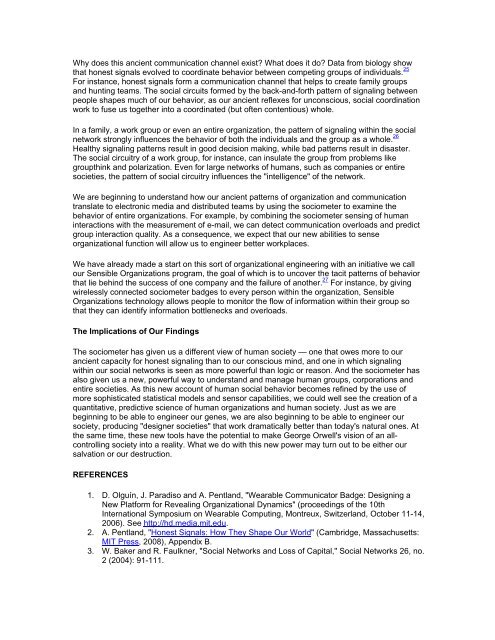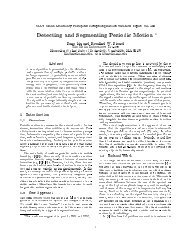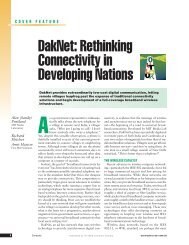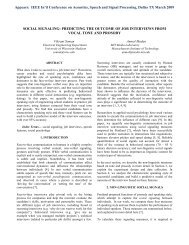'Honest Signals' in Business - Human Dynamics Group - MIT
'Honest Signals' in Business - Human Dynamics Group - MIT
'Honest Signals' in Business - Human Dynamics Group - MIT
You also want an ePaper? Increase the reach of your titles
YUMPU automatically turns print PDFs into web optimized ePapers that Google loves.
Why does this ancient communication channel exist? What does it do? Data from biology showthat honest signals evolved to coord<strong>in</strong>ate behavior between compet<strong>in</strong>g groups of <strong>in</strong>dividuals. 25For <strong>in</strong>stance, honest signals form a communication channel that helps to create family groupsand hunt<strong>in</strong>g teams. The social circuits formed by the back-and-forth pattern of signal<strong>in</strong>g betweenpeople shapes much of our behavior, as our ancient reflexes for unconscious, social coord<strong>in</strong>ationwork to fuse us together <strong>in</strong>to a coord<strong>in</strong>ated (but often contentious) whole.In a family, a work group or even an entire organization, the pattern of signal<strong>in</strong>g with<strong>in</strong> the socialnetwork strongly <strong>in</strong>fluences the behavior of both the <strong>in</strong>dividuals and the group as a whole. 26Healthy signal<strong>in</strong>g patterns result <strong>in</strong> good decision mak<strong>in</strong>g, while bad patterns result <strong>in</strong> disaster.The social circuitry of a work group, for <strong>in</strong>stance, can <strong>in</strong>sulate the group from problems likegroupth<strong>in</strong>k and polarization. Even for large networks of humans, such as companies or entiresocieties, the pattern of social circuitry <strong>in</strong>fluences the "<strong>in</strong>telligence" of the network.We are beg<strong>in</strong>n<strong>in</strong>g to understand how our ancient patterns of organization and communicationtranslate to electronic media and distributed teams by us<strong>in</strong>g the sociometer to exam<strong>in</strong>e thebehavior of entire organizations. For example, by comb<strong>in</strong><strong>in</strong>g the sociometer sens<strong>in</strong>g of human<strong>in</strong>teractions with the measurement of e-mail, we can detect communication overloads and predictgroup <strong>in</strong>teraction quality. As a consequence, we expect that our new abilities to senseorganizational function will allow us to eng<strong>in</strong>eer better workplaces.We have already made a start on this sort of organizational eng<strong>in</strong>eer<strong>in</strong>g with an <strong>in</strong>itiative we callour Sensible Organizations program, the goal of which is to uncover the tacit patterns of behaviorthat lie beh<strong>in</strong>d the success of one company and the failure of another. 27 For <strong>in</strong>stance, by giv<strong>in</strong>gwirelessly connected sociometer badges to every person with<strong>in</strong> the organization, SensibleOrganizations technology allows people to monitor the flow of <strong>in</strong>formation with<strong>in</strong> their group sothat they can identify <strong>in</strong>formation bottlenecks and overloads.The Implications of Our F<strong>in</strong>d<strong>in</strong>gsThe sociometer has given us a different view of human society — one that owes more to ourancient capacity for honest signal<strong>in</strong>g than to our conscious m<strong>in</strong>d, and one <strong>in</strong> which signal<strong>in</strong>gwith<strong>in</strong> our social networks is seen as more powerful than logic or reason. And the sociometer hasalso given us a new, powerful way to understand and manage human groups, corporations andentire societies. As this new account of human social behavior becomes ref<strong>in</strong>ed by the use ofmore sophisticated statistical models and sensor capabilities, we could well see the creation of aquantitative, predictive science of human organizations and human society. Just as we arebeg<strong>in</strong>n<strong>in</strong>g to be able to eng<strong>in</strong>eer our genes, we are also beg<strong>in</strong>n<strong>in</strong>g to be able to eng<strong>in</strong>eer oursociety, produc<strong>in</strong>g "designer societies" that work dramatically better than today's natural ones. Atthe same time, these new tools have the potential to make George Orwell's vision of an allcontroll<strong>in</strong>gsociety <strong>in</strong>to a reality. What we do with this new power may turn out to be either oursalvation or our destruction.REFERENCES1. D. Olguín, J. Paradiso and A. Pentland, "Wearable Communicator Badge: Design<strong>in</strong>g aNew Platform for Reveal<strong>in</strong>g Organizational <strong>Dynamics</strong>" (proceed<strong>in</strong>gs of the 10thInternational Symposium on Wearable Comput<strong>in</strong>g, Montreux, Switzerland, October 11-14,2006). See http://hd.media.mit.edu.2. A. Pentland, "Honest Signals: How They Shape Our World" (Cambridge, Massachusetts:<strong>MIT</strong> Press, 2008), Appendix B.3. W. Baker and R. Faulkner, "Social Networks and Loss of Capital," Social Networks 26, no.2 (2004): 91-111.






